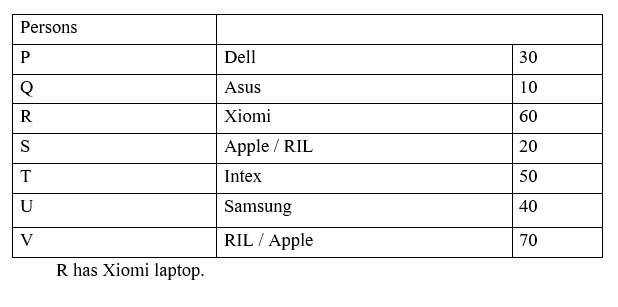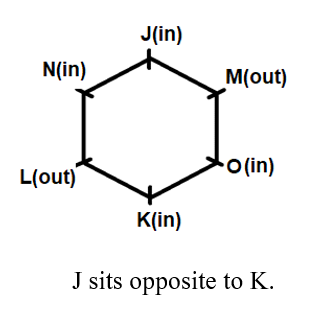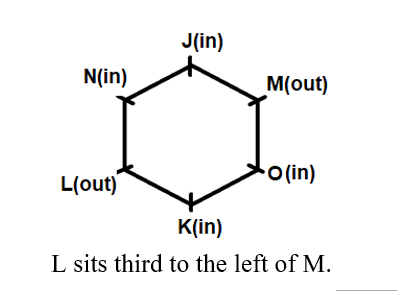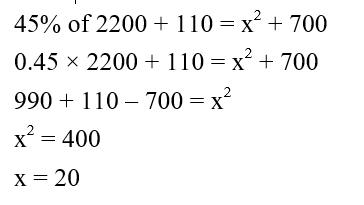Question 1:
Directions Answer the questions based on the information given below.
निर्देश: नीचे दी गई जानकारी के आधार पर प्रश्नों के उत्तर दें।
Seven persons P, Q, R, S, T, U and V have different number of laptops among 10, 20, 30, 40, 50, 60 and 70 but not necessarily in same order. Each of them has laptop of different brands among Asus, Apple, Dell, Intex, RIL, Samsung, Xiomi.
U has Samsung laptops.S has 20 laptops. The difference in number of laptops of P and V is 40.One person has 60 Xiomi laptops. Neither Q nor T has Xiomi laptops. V has more laptops than that of R. One person has 50 intex laptops. T has more laptops than U, who does not have only 10 laptops. There are 20 more Dell laptops than Asus laptops.
सात व्यक्तियों P, Q, R, S, T, U और V के पास 10, 20, 30, 40, 50, 60 और 70 में से अलग-अलग संख्या में लैपटॉप हैं, लेकिन जरूरी नहीं कि इसी क्रम में हों। उनमें से प्रत्येक के पास एसस, एप्पल, डेल, इंटेक्स, RIL, सैमसंग, जिओमी के बीच विभिन्न ब्रांड के लैपटॉप हैं।
U के पास सैमसंग लैपटॉप हैं। S के पास 20 लैपटॉप हैं। P और V के लैपटॉप की संख्या का अंतर 40 है। एक व्यक्ति के पास 60 जिओमी लैपटॉप हैं। न तो Q और न ही T के पास जिओमी लैपटॉप हैं। V के पास R से अधिक लैपटॉप हैं। एक व्यक्ति के पास 50 इंटेक्स लैपटॉप हैं। T के पास U से अधिक लैपटॉप हैं और U के पास केवल 10 लैपटॉप नहीं हैं। एसस लैपटॉप से डेल लैपटॉप 20 अधिक हैं।
Who among the following has Xiomi laptop?
निम्नलिखित में से किसके पास जिओमी लैपटॉप है?
Question 2:
Directions Answer the questions based on the information given below.
निर्देश: नीचे दी गई जानकारी के आधार पर प्रश्नों के उत्तर दें।
Seven persons P, Q, R, S, T, U and V have different number of laptops among 10, 20, 30, 40, 50, 60 and 70 but not necessarily in same order. Each of them has laptop of different brands among Asus, Apple, Dell, Intex, RIL, Samsung, Xiomi.
U has Samsung laptops.S has 20 laptops. The difference in number of laptops of P and V is 40.One person has 60 Xiomi laptops. Neither Q nor T has Xiomi laptops. V has more laptops than that of R. One person has 50 intex laptops. T has more laptops than U, who does not have only 10 laptops. There are 20 more Dell laptops than Asus laptops.
सात व्यक्तियों P, Q, R, S, T, U और V के पास 10, 20, 30, 40, 50, 60 और 70 में से अलग-अलग संख्या में लैपटॉप हैं, लेकिन जरूरी नहीं कि इसी क्रम में हों। उनमें से प्रत्येक के पास एसस, एप्पल, डेल, इंटेक्स, RIL, सैमसंग, जिओमी के बीच विभिन्न ब्रांड के लैपटॉप हैं।
U के पास सैमसंग लैपटॉप हैं। S के पास 20 लैपटॉप हैं। P और V के लैपटॉप की संख्या का अंतर 40 है। एक व्यक्ति के पास 60 जिओमी लैपटॉप हैं। न तो Q और न ही T के पास जिओमी लैपटॉप हैं। V के पास R से अधिक लैपटॉप हैं। एक व्यक्ति के पास 50 इंटेक्स लैपटॉप हैं। T के पास U से अधिक लैपटॉप हैं और U के पास केवल 10 लैपटॉप नहीं हैं। एसस लैपटॉप से डेल लैपटॉप 20 अधिक हैं।
V has _____ laptops.
V के पास _____ लैपटॉप हैं।
Question 3:
Directions Answer the questions based on the information given below.
निर्देश: नीचे दी गई जानकारी के आधार पर प्रश्नों के उत्तर दें।
Seven persons P, Q, R, S, T, U and V have different number of laptops among 10, 20, 30, 40, 50, 60 and 70 but not necessarily in same order. Each of them has laptop of different brands among Asus, Apple, Dell, Intex, RIL, Samsung, Xiomi.
U has Samsung laptops.S has 20 laptops. The difference in number of laptops of P and V is 40.One person has 60 Xiomi laptops. Neither Q nor T has Xiomi laptops. V has more laptops than that of R. One person has 50 intex laptops. T has more laptops than U, who does not have only 10 laptops. There are 20 more Dell laptops than Asus laptops.
सात व्यक्तियों P, Q, R, S, T, U और V के पास 10, 20, 30, 40, 50, 60 और 70 में से अलग-अलग संख्या में लैपटॉप हैं, लेकिन जरूरी नहीं कि इसी क्रम में हों। उनमें से प्रत्येक के पास एसस, एप्पल, डेल, इंटेक्स, RIL, सैमसंग, जिओमी के बीच विभिन्न ब्रांड के लैपटॉप हैं।
U के पास सैमसंग लैपटॉप हैं। S के पास 20 लैपटॉप हैं। P और V के लैपटॉप की संख्या का अंतर 40 है। एक व्यक्ति के पास 60 जिओमी लैपटॉप हैं। न तो Q और न ही T के पास जिओमी लैपटॉप हैं। V के पास R से अधिक लैपटॉप हैं। एक व्यक्ति के पास 50 इंटेक्स लैपटॉप हैं। T के पास U से अधिक लैपटॉप हैं और U के पास केवल 10 लैपटॉप नहीं हैं। एसस लैपटॉप से डेल लैपटॉप 20 अधिक हैं।
Which of the following pair is correct?
निम्नलिखित में से कौन-सा जोड़ा सही है?
Question 4:
Directions Answer the questions based on the information given below.
निर्देश: नीचे दी गई जानकारी के आधार पर प्रश्नों के उत्तर दें।
Seven persons P, Q, R, S, T, U and V have different number of laptops among 10, 20, 30, 40, 50, 60 and 70 but not necessarily in same order. Each of them has laptop of different brands among Asus, Apple, Dell, Intex, RIL, Samsung, Xiomi.
U has Samsung laptops.S has 20 laptops. The difference in number of laptops of P and V is 40.One person has 60 Xiomi laptops. Neither Q nor T has Xiomi laptops. V has more laptops than that of R. One person has 50 intex laptops. T has more laptops than U, who does not have only 10 laptops. There are 20 more Dell laptops than Asus laptops.
सात व्यक्तियों P, Q, R, S, T, U और V के पास 10, 20, 30, 40, 50, 60 और 70 में से अलग-अलग संख्या में लैपटॉप हैं, लेकिन जरूरी नहीं कि इसी क्रम में हों। उनमें से प्रत्येक के पास एसस, एप्पल, डेल, इंटेक्स, RIL, सैमसंग, जिओमी के बीच विभिन्न ब्रांड के लैपटॉप हैं।
U के पास सैमसंग लैपटॉप हैं। S के पास 20 लैपटॉप हैं। P और V के लैपटॉप की संख्या का अंतर 40 है। एक व्यक्ति के पास 60 जिओमी लैपटॉप हैं। न तो Q और न ही T के पास जिओमी लैपटॉप हैं। V के पास R से अधिक लैपटॉप हैं। एक व्यक्ति के पास 50 इंटेक्स लैपटॉप हैं। T के पास U से अधिक लैपटॉप हैं और U के पास केवल 10 लैपटॉप नहीं हैं। एसस लैपटॉप से डेल लैपटॉप 20 अधिक हैं।
What is the sum of number of laptops of U and R?
U और R के लैपटॉप की संख्या का योग क्या है?
Question 5:
Directions Answer the questions based on the information given below.
निर्देश: नीचे दी गई जानकारी के आधार पर प्रश्नों के उत्तर दें।
Seven persons P, Q, R, S, T, U and V have different number of laptops among 10, 20, 30, 40, 50, 60 and 70 but not necessarily in same order. Each of them has laptop of different brands among Asus, Apple, Dell, Intex, RIL, Samsung, Xiomi.
U has Samsung laptops.S has 20 laptops. The difference in number of laptops of P and V is 40.One person has 60 Xiomi laptops. Neither Q nor T has Xiomi laptops. V has more laptops than that of R. One person has 50 intex laptops. T has more laptops than U, who does not have only 10 laptops. There are 20 more Dell laptops than Asus laptops.
सात व्यक्तियों P, Q, R, S, T, U और V के पास 10, 20, 30, 40, 50, 60 और 70 में से अलग-अलग संख्या में लैपटॉप हैं, लेकिन जरूरी नहीं कि इसी क्रम में हों। उनमें से प्रत्येक के पास एसस, एप्पल, डेल, इंटेक्स, RIL, सैमसंग, जिओमी के बीच विभिन्न ब्रांड के लैपटॉप हैं।
U के पास सैमसंग लैपटॉप हैं। S के पास 20 लैपटॉप हैं। P और V के लैपटॉप की संख्या का अंतर 40 है। एक व्यक्ति के पास 60 जिओमी लैपटॉप हैं। न तो Q और न ही T के पास जिओमी लैपटॉप हैं। V के पास R से अधिक लैपटॉप हैं। एक व्यक्ति के पास 50 इंटेक्स लैपटॉप हैं। T के पास U से अधिक लैपटॉप हैं और U के पास केवल 10 लैपटॉप नहीं हैं। एसस लैपटॉप से डेल लैपटॉप 20 अधिक हैं।
Who among the following has RIL laptops?
निम्नलिखित में से किसके पास आर आई एल लैपटॉप हैं?
Question 6:
Directions : Answer the questions based on the information given below.
नीचे दी गई जानकारी के आधार पर प्रश्नों के उत्तर दें।
Six persons, J, K, L, M, N and O are sitting at the corners of hexagonal shaped table. Some of them facing towards the center while others are facing outside the table.
One person is sitting between N and M but both of them facing opposite directions with respect to each other (i.e. if N facing towards the center then M must be facing away from the center and vice versa). N sits second to the left of K, who faces towards the center. O sits second to the left of L, who faces outside the table. L sits 2nd to the right of J, who sits immediate left of M. L and O face the opposite directions with respect to each other. O and M are immediate right of each other.
छह व्यक्ति, J, K, L, M, N और O षट्कोणीय आकार की मेज के कोनों पर बैठे हैं। उनमें से कुछ व्यक्तियों का मुख केंद्र की ओर है जबकि अन्य के मुख मेज के केंद्र से बाहर की ओर है।
एक व्यक्ति N और M के बीच में बैठा है, लेकिन दोनों का मुख एक दूसरे के सन्दर्भ में विपरीत दिशाओं की ओर है (अर्थात यदि N का मुख केंद्र की ओर है तो M का मुख केंद्र से बाहर की ओर होना चाहिए और इसके विपरीत)। N K के बाएं से दूसरे स्थान पर बैठा है और K का मुख केंद्र की ओर है। O L के बाएं से दूसरे स्थान पर बैठा है और L का मुख मेज के केंद्र से बाहर की ओर है। L J के दाएं से दूसरे स्थान पर बैठा है और J M के तत्काल बाएं ओर बैठा है। L और O एक दूसरे के सन्दर्भ में विपरीत दिशाओं की ओर मुख किए हुए हैं। O और M एक दूसरे के तत्काल दाएं ओर बैठे हैं।
Who sits opposite to K in the table?
K के विपरीत कौन बैठा है?
Question 7:
Directions : Answer the questions based on the information given below.
नीचे दी गई जानकारी के आधार पर प्रश्नों के उत्तर दें।
Six persons, J, K, L, M, N and O are sitting at the corners of hexagonal shaped table. Some of them facing towards the center while others are facing outside the table.
One person is sitting between N and M but both of them facing opposite directions with respect to each other (i.e. if N facing towards the center then M must be facing away from the center and vice versa). N sits second to the left of K, who faces towards the center. O sits second to the left of L, who faces outside the table. L sits 2nd to the right of J, who sits immediate left of M. L and O face the opposite directions with respect to each other. O and M are immediate right of each other.
छह व्यक्ति, J, K, L, M, N और O षट्कोणीय आकार की मेज के कोनों पर बैठे हैं। उनमें से कुछ व्यक्तियों का मुख केंद्र की ओर है जबकि अन्य के मुख मेज के केंद्र से बाहर की ओर है।
एक व्यक्ति N और M के बीच में बैठा है, लेकिन दोनों का मुख एक दूसरे के सन्दर्भ में विपरीत दिशाओं की ओर है (अर्थात यदि N का मुख केंद्र की ओर है तो M का मुख केंद्र से बाहर की ओर होना चाहिए और इसके विपरीत)। N K के बाएं से दूसरे स्थान पर बैठा है और K का मुख केंद्र की ओर है। O L के बाएं से दूसरे स्थान पर बैठा है और L का मुख मेज के केंद्र से बाहर की ओर है। L J के दाएं से दूसरे स्थान पर बैठा है और J M के तत्काल बाएं ओर बैठा है। L और O एक दूसरे के सन्दर्भ में विपरीत दिशाओं की ओर मुख किए हुए हैं। O और M एक दूसरे के तत्काल दाएं ओर बैठे हैं।
Who sits third to the left of M?
M के बाएं से तीसरे स्थान पर कौन बैठा है?
Question 8:
Rakesh goes to school with a speed of 8 km/hr and returns with a speed of 6 km/hr. If the total time taken by Rakesh in the journey from home to school and back is 14 hours, then find the distance between school and home of Rakesh.
राकेश 8 किमी/घंटा की गति से स्कूल जाता है और 6 किमी/घंटा की गति से लौटता है। यदि राकेश द्वारा घर से स्कूल और वापस आने में लिया गया कुल समय 14 घंटे है, तो राकेश के स्कूल और घर के बीच की दूरी ज्ञात कीजिए।
Question 9:
The ratio of speed of a boat in still water and the speed of the current is 7:5, respectively. If the speed of the boat in still water had been twice, then it would have travelled 228 km downstream in 4 hours. Find upstream speed of boat.
शांत जल में एक नाव की गति और धारा की गति का अनुपात क्रमशः 7:5 है। यदि शांत जल में नाव की गति दुगनी होती, तो वह धारा अनुप्रवाह में 228 किमी की दूरी को तय करने में 4 घंटे लगते। नाव की धारा विरुद्ध गति ज्ञात कीजिए।
Question 10:
When 45% of 2200 is added to 110 the resultant is 700 more than square of ‘x’. Find the value of ‘x’.
जब 2200 के 45% को 110 में जोड़ा जाता है तो परिणामी 'x' के वर्ग से 700 अधिक है। ‘x’ का मान ज्ञात करें?








